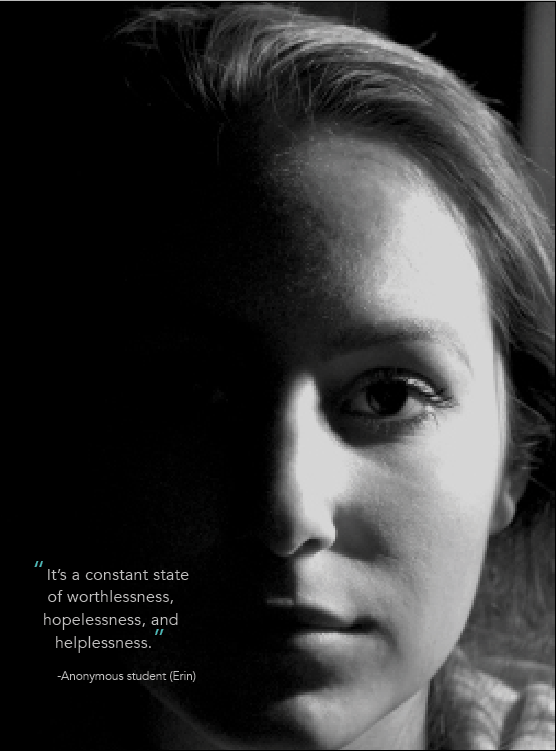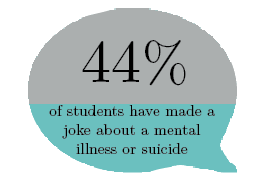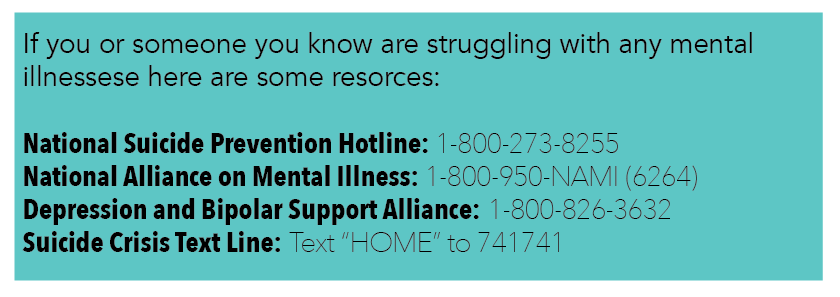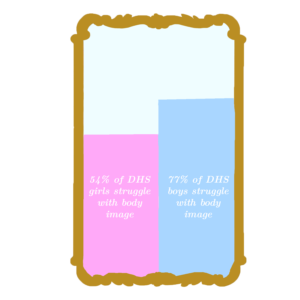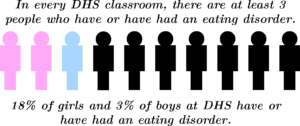Mental illness can be as severe as other illnesses, but students say even though they are hard to see, they are still there
By Tess Alekseev, Heather Brouwer, Isabella Franklin, Evelyn Maxey, Kira Perry, and Rachel Wittenberg
At five years old, she was so angry with herself for upsetting her mother that she placed a sign outside her bedroom door saying she was going to kill herself.
“I was so scared of getting in trouble,” an anonymous student at DHS who will hereafter be referred to as Erin said. “I thought this [reaction] was normal, but my mom immediately freaked out and took me to the hospital. That was kind of the wake-up call, that maybe something wasn’t right.”
Having an anxiety disorder has significantly impacted the way she feels in school and other social settings. Her mind is dominated by impossible standards she has set for herself in order to manipulate the way others perceive her.
“I’m constantly worried about what other people think of me, and I’m constantly assuming what other people think of me even if it’s maybe not true,” Erin said.
The anxiety controls her; every action is ruled by the fear of what others may be thinking of her.
Mental illness not only hinders the way you interact with others, but the way you connect with yourself.
“It’s a constant state of worthlessness, hopelessness, and helplessness,” Erin said.
Your thoughts, day after day, assign you little value, and after awhile, the line between what you’re supposed to think and what depression makes you feel become blurred; however, the stigma around mental illness only obstructs those suffering from reaching out to receive the help they need.
“[The stigma] makes a lot of my battles silent even to this day, because I don’t think I should get help because I’m like, ‘oh I’m fine’ when I know I’m not,” Erin said.
Erin is not alone.
After a survey was given to 110 of DHS students, 38% of students said that they or someone they were close with had been affected by depression, anxiety, or both.
It is not just a few people, it is millions of people around the world.
According to the Anxiety and Depression Association of America, 25.1% of children between 13 and 18 years old are affected by anxiety disorders, and 2.8 million teenagers from ages 12 to 17 have experienced at least one major depressive episode.
I started feeling it around 14, an anonymous upperclassman said. I always felt really sad. I didn’t want to leave the house in different situations. We would have parties and there were a lot of people and I would get anxious.
This is another case of anxiety and depression as experienced by a high school student.
Types of depression range from the most common being major depressive disorder (also known as clinical depression), to bipolar depression, persistent depressive disorder, seasonal affective disorder (SAD), psychotic depression, and more. However, when people say the word “depression,” they are usually referring to major depressive disorder.
Depression isn’t just sadness. There are a wide variety of symptoms that severely affect someone’s daily life. Some of the most common include: feelings of guilt, worthlessness, and helplessness; insomnia or sleeping too much; loss of interest in activities one used to enjoy; persistent sad, anxious, or “empty” feelings; desire to severely harm one’s self.
“Depression can show up as having a hard time eating, sleeping, and not being really interested in life in the ways that the person is used to anymore,” Melissa Butler, a therapist at Mindful Solutions, said. “In all cases of depression it can be really hard to focus and to concentrate and just to feel okay in yourself.”
The causes of depression are also wide ranging. Often, a traumatic life event may be the cause. In other cases, some people are born with a chemical imbalance in the brain due to family history or genetic makeup. The cause can even be as simple as stressful living conditions.
“The people who end up in my office often times means that they had a rough time growing up,” Butler said. “How that presents in terms of what people are struggling with is often times anxiety, depression, problems with relationships, and bipolar disorder.”
Depression and anxiety aren’t untreatable. Progress can be made with medicine, talking to someone like a therapist, and changes to one’s lifestyle.
“[Treatment is] very specific to the person,” Butler said. “Speaking generally, what I have found is really helpful for people is a kind of team approach to getting better and what that looks like is the person themselves being committed and invested in their journey through their hardship. That means going to therapy, doing the hard work, and experiencing difficult emotions, but depending on where the person is at, it means working with a psychiatrist and medication, sometimes it involves nutrition, sometimes it involves physical health like exercise, and also modalities like acupuncture and massage can be really helpful in addition to things like group therapy.”
For Erin, using her passions to help her deal with depression was one of the best remidies.
“Find one thing that you’re good at and do that and pursue that, and don’t give a shit about what other people say,” Erin said. “For me, it’s helping people. Like working with children, especially because I love doing that.”
For the upperclassman previously mentioned, medication was the best way to treat her anxiety and depression. She takes a type of medication to help both.
“It calms it down and helps it not affect you,” she said. She also uses deep breathing techniques and talking to her mom to help her cope with her anxiety and depression.
With time and the right treatments, mental illness is not a life sentence.
“As you get older you learn not to care about it,” the upperclassman said.
It is possible to overcome mental illness, but to get there, you have to overcome the stigma and get help. Having a mental illnesses does not make you a psychopath.
“There is a lot of stigma in our society about what mental health issues really mean,” Butler said. “I think one misconception is that if somebody has mental health issues they are crazy, just using a pop-culture term. They are kind of unreliable that what they are saying might not be valid or that their interpretations or perceptions of things might not be correct. That’s not necessarily true.”
We must rise above those preconceived ideas, Butler said, because mental illnesses are hard enough to deal with.
“It is really hard for a lot of people for a lot of reasons to reach out and get help,” Butler said. “People are really scared that if they get help that means they are crazy or something is wrong with them… and the thing is, we can’t force people to get help when they aren’t ready for it. At the same time that doesn’t mean withdrawing support.”
A student echoes Butler’s feelings.
“You can get someone else to pick you up when you feel like you are at rock bottom,” another student who struggles with depression and anxiety said.
After choking on a piece of food, an anonymous sophomore constantly felt like there was something stuck in her throat. She developed an extreme phobia of eating solid food, fearing that she would choke again or that she would gain weight.
The sophomore has dealt with eating disorders firsthand. She struggled with body image as a child, but it didn’t become a serious issue until she was 11.
The sophomore didn’t realize that she had anorexia nervosa until she fainted during a choir concert, having not eaten all day. After going through two years of treatment, she was able to have a healthy relationship with food.
“I’m fully recovered, but it still hurts to see girls wanting to be like me when I had anorexia,” the sophomore said. “They say things like, ‘I’m so fat, oh, I’m not gonna eat.’ That’s a terrible idea, to stop eating. You’re going to end up in the hospital with a tube.”
The sophomore’s statement may seem extreme, but more often than not, this is the reality for anorexia sufferers.
Though anorexia recovery focuses on talk therapy and behavioral changes, any health emergencies, such as a dangerously low body weight, must be taken care of first. And in anorexic patients with a fear of eating, this can be difficult to do without nasogastric feeding, which involves a tube being placed into the nose through which food can be carried to the stomach.
“One of the reasons I was afraid of eating … was choking, so when they put the tube down my throat, it felt like I was dying. It was really scary,” the sophomore said.
Courtney Melvin, a freshman at Dexter, has faced a different side of eating disorders: EDNOS (Eating Disorder Not Otherwise Specified).
“I go through cycles of binging on food, and then restricting,” Melvin said. “I’ll go back, and eat healthy, and then I’ll sort of ease back into it.”
EDNOS is a side of eating disorders that doesn’t often get a lot of attention. Patients with EDNOS have a higher mortality rate than anorexia and bulimia according to Medscape, and another danger lies in the inability to identify the fact that an eating disorder is present due to the lack of awareness about eating disorders that aren’t anorexia or bulimia.
“It took a bit of time — it started out when I was younger, around 11, and I would say, ‘I can’t eat this because … blah, blah, blah,’” Melvin said, “When I was older, I started thinking that it was weird, like, there has to be something wrong here. I didn’t wanna be that one girl who said she had an eating disorder [without diagnosis], because that’s annoying, but when I was hospitalized, I was diagnosed [with EDNOS], which was… really reassuring.”
“My mom thought there was something physically wrong with me, but seven doctors didn’t find anything wrong with me, so we went to a therapist and they tested me for depression and anxiety,” the sophomore said, “I was in a bubble — I didn’t want to talk to anyone, or go outside, or do anything.”
“With eating disorders, you have to stop comparing yourself to others,” the sophomore said. What you see in the media, magazines and photoshop, you need to learn to love yourself.”
When you’re younger, having an imaginary friend isn’t out of the ordinary, but living a life where you don’t know the difference between reality and illusion can be unsettling.
“It can be scary sometimes when I am not able to tell if something is real or in my imagination, especially in front of others who don’t understand my disease,” an anonymous upperclassmen said.
The student has been struggling with schizophrenia for almost four years. Every since first realizing something wasn’t quite right, the student has been trying to get a handle on the illness.
Schizophrenia is a chronic and debilitating mental disorder that affects how a person thinks, feels, and behaves. People with schizophrenia tend to feel like they have lost touch with reality and experience severe symptoms of paranoia: hallucinations, delusions, abnormal mood swings, and overall difficulty functioning normally.
Although schizophrenia is not as common as other mental disorders, the symptoms can be disabling and extremely difficult for a person to live a normal life. It may be challenging, but it isn’t impossible.
In the United States, about 1 in 4,000 people are diagnosed with schizophrenia yearly, or just over 200,000 cases per year according to the research foundation Brain and Behavior.
“I would say the most infuriating of it all is knowing my thoughts aren’t normal, but that I can’t control them,” the upperclassman said.
Although schizophrenia is a rare and complex mental disorder, it is possible to live well with it. There is no known cure for schizophrenia; nonetheless, it can be treated and managed in several ways that can give them the capability to live a moderately normal life.
“It isn’t a violent thing, people make it that way,” they said. “It will always be scarier for me than for anyone else around me.”
“My dad, prior to this, was a very charismatic person, but there were just these extremes [of emotion] for a while then he would come back,” an anonymous senior said. “He would go on these random trips with us, and [he] was just very unstable.”
This is bipolar disorder.
“There’s not just one kind of bipolar disorder,” Butler said. “There are two different types of bipolar disorder, and one type of bipolar disorder is where people swing from a very intense stage of a lot of energy that can show up as anger. It can show up as impulsivity. It can show up like not sleeping, and often times feels good to the person who is experiencing it. Then, on the other end of the spectrum, that person might swing into a really low stage that looks a lot like depression.
“Then there is another kind of bipolar disorder. It is characterized by hypomania and hypomania, and looks a lot more like having a foot on the gas and one foot on the brake at the same time.”
It is behaviors like anger, impulsivity, and regular mood swings that can make it stressful for families and friends of people diagnosed with bipolar disorder.
“My parents are divorced, and I think him getting sick was, not that I blame him for it, a big factor,” the senior said. “He wouldn’t get help. Even though 2008 wasn’t that long ago, I think people didn’t recognize it as well. So nobody understood it.”
According to the National Institute of Mental Health, more than 5.7 million Americans over the age of 18 are diagnosed with bipolar disorder, and about 2.2% of youth meet the criteria for bipolar disorder in a given year.
Bipolar disorder is very difficult to diagnose because the symptoms present are similar to many other disorders, making it difficult for professionals to diagnose those affected.
“[Bipolar disorder] did carry on in his life for quite a while,” the senior said. “He just didn’t address it until later in his life when it got pretty dramatic when I was about 8.”
While this disorder is not curable, the symptoms can be treated through medication, therapy, and other methods. And while these medications help mediate the swings between depression and elation, they can have adverse side effects on a person’s daily behavior.
“From 2008 to 2015, I really distanced myself from my dad, but now he is calmer because he is getting treatment and is on medication,” the senior said. “But, it’s hard because my dad is on such high medication, so he is a lot slower than he used to be. It’s just hard seeing the difference.”
There isn’t just a difference between medicated and unmedicated bipolar disorder; there is also a huge difference between the stereotype of the disorder and what it actually represents to those who have loved ones with the disorder.
“Don’t use the stereotypical things [to judge bipolar disorder],” the senior said. “When people are having a rough day or snapping at people, [people ask] ‘are you bipolar?’ You need to steer away from that.’’
“I think we need to celebrate progression more than perfection. We idolize people who are perfect, and we don’t really value the progression. We have these huge dramatic stigmas about mental illness, and we need to realize that all these things are in everyone, just in different amounts.”

